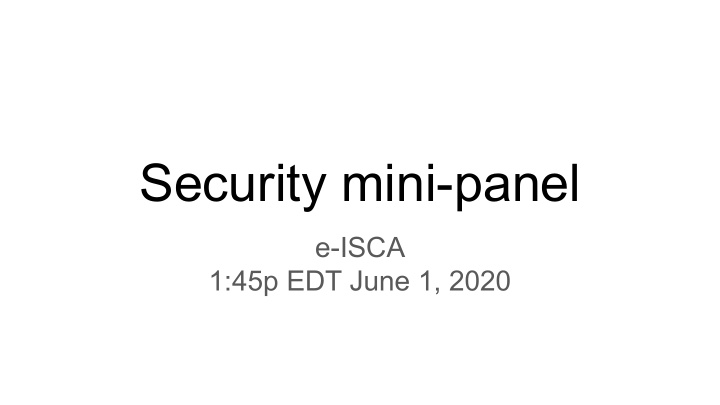



Security mini-panel e-ISCA 1:45p EDT June 1, 2020
Panelists Chris Fletcher Caroline Trippel Assistant Professor, UIUC Assistant Professor, Stanford Ed Suh Frank Mckeen Professor, Cornell Security/Computer Architect, Intel
Panel format and purpose Goal: what’s next, and what is our community’s role, in processor security? Format: 1.) Opening statements. 2.) Open to discussion. Audience please submit questions via zoom/whova! Some examples: What are computer architects’ roles in finding new attacks? Is the way we design computers fundamentally ill-equipped to deal with security? What is the role of formal methods in designing secure hardware? What is the role of computer architecture (and comp. architects) in security?
Opening statement - Chris A lot of my time: “verifiable defenses”: security property → abstractions/interfaces → implementations → (hopefully someday) automatically verified Today: Computer Architects should be the ones to find the next major uarch attack My ugrad comp arch class https://cyber.wtf/author/andersfogh1974/ Most attack research “Behind the scenes of a bug collision” Computer Architecture is about exploiting the common case. Processor Security is about what cool things happen (good or bad) when you induce the worst case.
Opening statement - Caroline Themes of my current work: security as a first-order computer architecture design constraint · formal methods for computer architecture · formal security verification · interface specifications for security · application specific security Today: The complexity of both modern microprocessor designs and hardware security vulnerabilities requires computer architects to devise mechanisms for enabling formal, automated security verification. Design for security verification Interface specs. for security Application-specific security
Application-Driven, Full-System, Security Assurance Today’s research : Largely driven by known attacks on Application general-purpose CPUs with empirical security evaluation Challenge/Opportunity: abstractions, interfaces, and Other Systems mechanisms, and tools for full-system assurance for Software application-level security properties ● Abstractions and interfaces for HW-SW, HW-HW: hide GPU implementation, composable security NPU ● Architecture and tools for formal security assurance ● Assurance for users and other systems CPU ● Application-driven: new security properties, specialized 5G? protection for lower overhead and complexity
Recommend
More recommend